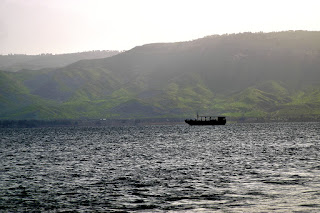Stories of Old and New Testaments come to life on trip to Holy Land
By Mike Haynes
My biggest
surprise when I visited the Holy Land for the first time last month had less to
do with faith than terrain.
Israel is a
lot more vertical than horizontal. Or at least Galilee and Jerusalem are.
Yes, the
area around the Dead Sea, south toward Egypt and east toward Jordan turn into
desert – some flat and some mountainous – which is how I had pictured the land
where Jesus walked. And west toward the Mediterranean turns into coastal plains.
But much of
the region where Jesus spent his time is lushly green with steep hills and
valleys. In fact, to walk from place to place in Jerusalem itself – or in Nazareth
or Bethlehem – the disciples would have climbed hills and descended into
valleys. There’s a reason the site of the second Jewish temple is called the
Temple Mount and across the way is the Mount of Olives.
As our Amarillo tour leader said,
Jesus and his followers would have been in good shape.
Such mundane, physical realizations
are one reason the stories and events in the Old and New Testaments do come to
life when you stand in that small Middle Eastern country. I had read and heard that
Jesus preached the Sermon on the Mount, but when you stand at the top of a
slope next to the Sea of Galilee which provides excellent acoustics, you can
picture the Beatitudes actually being voiced there.
When you look at the remains of a
stone house in Capernaum that archeologists are pretty sure is the house of the
apostle Peter or his mother-in-law, you know that the man who also was God had
to have been there, too.
My wife, Kathy, and I were blessed
to be able to visit those sites and many more with 73 other people, mostly from
Amarillo, on a trip sponsored by Washington Avenue Christian Church. For most,
it was our first journey to Israel.
Getting there and getting home
certainly was a challenging journey for about half of us who
Once we reached the Tel Aviv
airport and then our hotel in Tiberias, on the shore of the Sea of Galilee, the
spirit of that land fell upon us. An Amarillo Sunday school teacher later asked
me if I could spend a month in one location
that we visited, where would it be?
I answered the Sea of Galilee, actually a lake, where Jesus walked on water and
around which much of his ministry centered. Modern buildings are clustered
around some of its waters, but many of the green hills and rocky beaches have
been left untouched. It’s easy to imagine Peter, John and the rest hanging out below
the hazy sky that hung above us in our short time there.
 |
This view from the Mount of Olives shows the Old City of
Jerusalem with
terraces and Islamic graves leading up
to the Temple Mount. (Photo by Kathy
Haynes)
|
I don’t see how a Christian could
visit Israel without having some kind of spiritual experience. My thoughts
about the vertical hills of the north and the horizontal desert of the south led
me to metaphors for our relationships: vertical with God and horizontal with
other people. A Jerusalem hotel Bible study led by a woman in our group was
more meaningful. Her prayer and scripture reading had led her to impress upon
us the need to consider how the trip would affect our lives when we returned to
Texas.
We were tourists, and we bought
T-shirts and olive wood souvenirs. We floated in the Dead Sea. We learned a
little about the current state of Israel, its relationship with the
Palestinians and the concrete walls that help keep the peace. But we also were
pilgrims, people who travel to a sacred place as an act of religious devotion,
as one dictionary puts it. Some of us were rebaptized in the Jordan River. We
prayed before every bus trip and silently at the Western Wall.
In the past 2,000 years, churches
have been built at many of the sites that are believed to have been important
in Jesus’ life – for example, the Church of the Nativity in Bethlehem and the
church next to the Garden of Gethsemane in Jerusalem. Who knows whether the
actual tomb of Jesus, from which he was resurrected, is under the elaborate
Church of the Holy Sepulchre or is 1,100 yards away, where the Garden Tomb
looks just as we imagine the entrance cut out of a hill where a round stone was
rolled away? No matter where it happened, we were close to it.
If you can, go see Israel for
yourself. It’s inspiring to walk where Jesus walked.
But if you don’t make it there, don’t
worry. More important is to walk with Jesus wherever you are.





